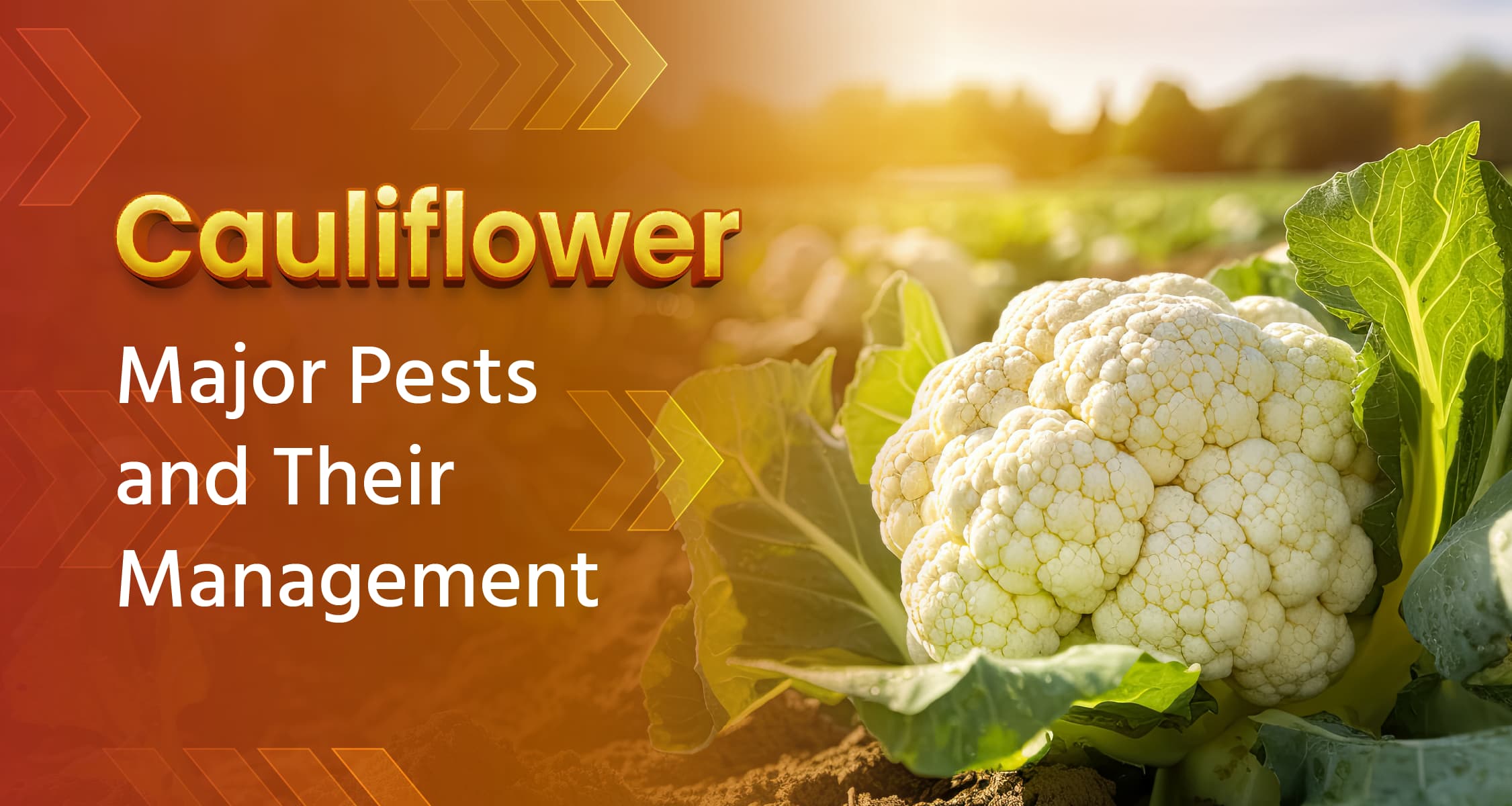Cauliflower: Major Pests and Their Management

The cultivation of cauliflower and cabbage is generally done during the cold weather. However, its cultivation in the greenhouse is being successfully carried out in almost all seasons. Cauliflower and cabbage crops are susceptible to various types of pests, therefore cauliflower pest and disease control is very much crucial for a successful harvest. These include diamondback moth (cabbage moth), tobacco caterpillar, cabbage aphid, leaf and fruit piercing moth, cabbage butterfly, cabbage maggot, etc. Hence, for a successful yield, it is important to have the necessary information about the damage and control measures from cauliflower pests and diseases to protect the crop from their infestation.
Major Pests and Their Management in Cauliflower
Damage Caused by Diamondback Moth
- This is the main pest of cauliflower crops. The larvae of this pest bore into the leaves and feed on them, causing only veins to appear on the leaves and small green-slate colored larvae of the moth can be seen when the leaf is shaken. These pests also cause damage to the crop fruits, resulting in significant losses to the farmers.
Methods of Control for Diamondback Moth
- Use 4-6 pheromone traps per acre.
- Mix 50 ml of Broflanilide 20% SC (PI- Brofreya) in 150-200 liters of water and apply per acre.
- Mix 300 ml of Novaluron 5.25% + Indoxacarb 4.5% w/w SC (Adama Plethora) in 150-200 liters of water and apply at the rate per acre.
- Mix 300 ml of Chlorfenapyr 10% SC (BASF Intrepid) in 150-200 liters of water and apply at the rate per acre.
- Mix 200-220 ml of Lufenuron 5.4% EC (Crystal Lunox) in 150-200 liters of water and apply at the rate per acre.
- Mix 300 ml of Novaluron 5.25% + Emamectin Benzoate 0.9% SC (UPL Gunther) in 150-200 liters of water and apply at the rate per acre.
Damage Caused by Tobacco Caterpillar
- This insect attacks in groups and feeds on tender leaves. Upon fruiting, it also damages cauliflower fruits, which becomes a significant cause of reduced yield.
Methods of Controlling Tobacco Caterpillar
- Use 4-6 pheromone traps per acre.
- Mix 10% of Novaluron EC (UPL Uniron) in a quantity of 300 ml in 150-200 liters of water and apply at the rate per acre.
- Mix 500 ml of Chlorophyriphos 20% EC (Tata Tafaban) with 150-200 liters of water and spray at the rate per acre.
- Mix 25-34 ml of Broflanilide 300 GL SC (BASF Exponus) with 150-200 liters of water and spray at the rate per acre.
Damage Caused by Cabbage Butterfly
- The caterpillars of this insect feed on the leaves of plants in clusters. They also destroy them by entering the flowers.
Control Methods for Cabbage Butterfly
- Mix 50-70 gm of Imidacloprid 70% WG (DeHaat Contropest) per acre with 150-200 liters of water and spray at the rate per acre.
- Mix 80-100 ml of Thiamethoxam 12.6% + Lambda-cyhalothrin 9.5% ZC (DeHaat Entokill) per acre with 150-200 liters of water and spray at the rate of per acre.
Damage Caused by Caterpillars in Cauliflower
- Its larvae and adult caterpillars suck sap from the leaves and flower cells. They are mostly seen on the leaves and terminal parts of the plant. The infestation of this caterpillar makes the plants unhealthy and the leaves curl. Affected parts become distorted. Black spots appear on the leaves due to the sweet sticky substances (honeydew) released by the caterpillar.
Control Measures for Caterpillars in Cauliflower
- Mix 50-70 gm of Imidacloprid 70% WG (DeHaat Contropest) in 150-200 liters of water and apply per acre.
- Mix 80-100 ml of Thiamethoxam 12.6% + Lambda-cyhalothrin 9.5% ZC (DeHaat Entokil) in 150-200 liters of water and apply per acre.
Damage Caused by Cabbage Maggot
- The larvae of this insect damage the small roots of plants. They also damage the leaves of plants.
Control Methods for Cabbage Maggot
- Mix 500 ml of Chlorophyriphos 20% EC (Tata Tafaban) in 150-200 liters of water and apply at the rate per acre.
Factors to Consider During Pesticide Application
- Use clean water to prepare the pesticide solution.
- Use 50-60 ml of silicone-based sticker (adhesive) per acre along with the pesticide.
- Wear full clothes during pesticide application to prevent the solution from touching your body.
- Use gloves on your hands.
- Cover your nose, mouth, and entire face properly.
- Do not apply pesticides when there is strong wind blowing.
- Apply pesticides in the evening.
- If you experience symptoms like burning sensations in your eyes, difficulty breathing, itching, etc., immediately seek advice from a doctor after pesticide application.
- Keep young children away from pesticides.
Which pest/insect infestation is more prevalent in cauliflower crops, and which medications do you use to control that cauliflower pest? Please let us know your answers in the comments. For more information on protecting crops from various diseases and pests, follow the 'Agri Doctor' channel now. Also, by liking and sharing this post, you can spread this information to more farmers.
Frequently Asked Questions (FAQs)
Q: How can we protect the cauliflower crop from pests?
A: Treat seeds and soil with pesticides and choose resistant varieties against pests. Avoid planting cauliflower in the same field repeatedly and adopt crop rotation.
Q: Which pests are found in cauliflower?
A: Various pests infest cruciferous vegetables (cauliflower, cabbage, broccoli). These include diamondback moths, aphids, and cabbage butterflies, among others. Some pests damage the plant roots, while others feed on the leaves, leading to reduced yield.
Q: What can be done for better yield?
A: For a higher yield of cauliflower and related vegetables, manage fertilization, irrigation, and nutrient levels timely. Ensure proper spacing during planting. Further, cauliflower disease and pest control are also very crucial to reduce harvest losses.
Please login to continue

Get free advice from a crop doctor
